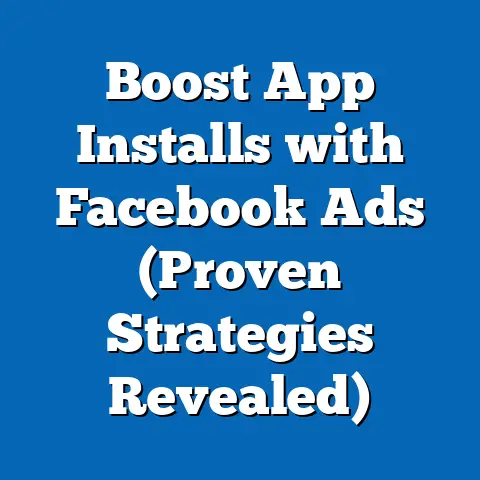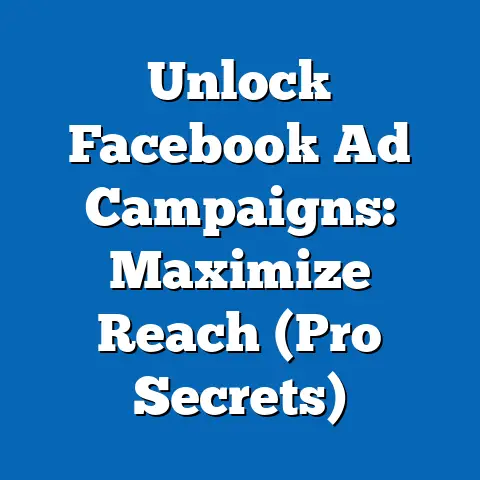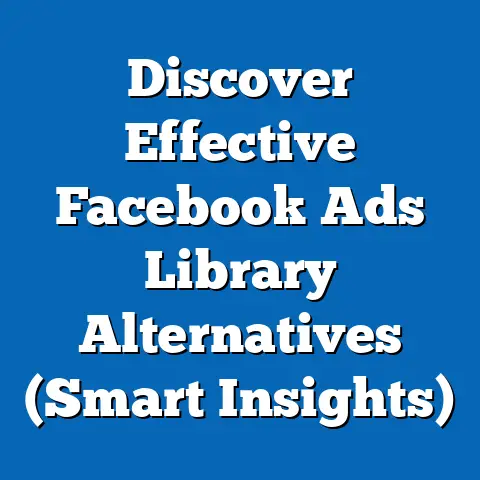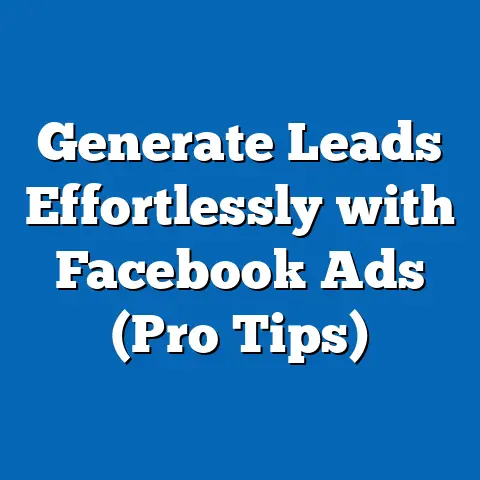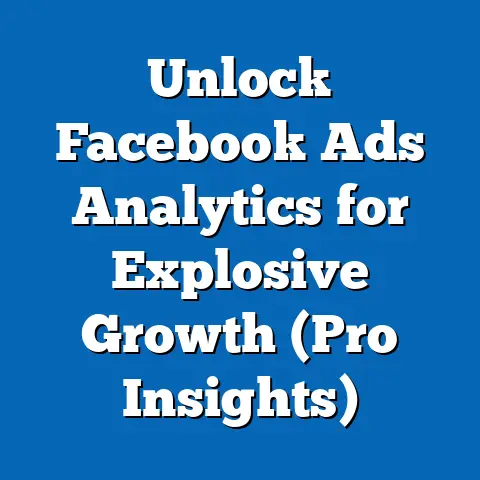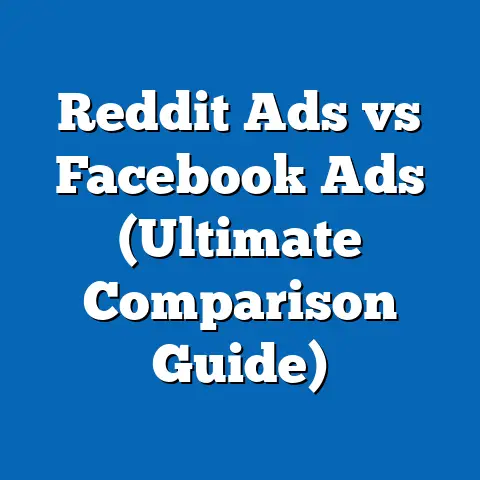Boost Facebook Engagement (Unblock Ads Effectively)
Facebook engagement is the lifeblood of any successful social media marketing strategy. It’s not just about racking up likes; it’s about creating meaningful interactions that foster brand loyalty and drive conversions. And a key, often overlooked, component of boosting that engagement is accessibility. In a world striving for inclusivity, ensuring your content is accessible isn’t just a moral imperative, it’s a strategic advantage that can unlock engagement from a wider audience. I’ve seen firsthand how focusing on accessibility can significantly impact the performance of Facebook ad campaigns. In this article, I’ll explore how effective ad strategies, rooted in accessibility, can unblock engagement and make your content relatable and engaging for a broader demographic.
Understanding Facebook Engagement
Facebook engagement encompasses all the ways users interact with your content. It goes beyond simple views and impressions to include concrete actions that demonstrate genuine interest. The key metrics I focus on include:
- Likes: A simple indication of approval or agreement.
- Shares: When users redistribute your content to their own networks, amplifying your reach.
- Comments: Direct feedback and discussions sparked by your posts.
- Click-Through Rates (CTR): The percentage of users who click on a link within your ad, indicating their interest in learning more.
These metrics are the building blocks of a thriving online presence. For brands, robust engagement translates to:
- Increased Reach: Higher engagement signals to Facebook’s algorithm that your content is valuable, leading to greater organic reach.
- Enhanced Visibility: Engaging content is more likely to appear in users’ newsfeeds, increasing brand awareness.
- Improved Conversion Rates: When users are actively engaged, they are more likely to convert into customers.
I’ve seen it happen time and again. Brands that prioritize engagement build stronger relationships with their audience and ultimately achieve better business outcomes.
The Data Speaks Volumes
Don’t just take my word for it. A recent study by HubSpot revealed that businesses that prioritize social media engagement are 58% more likely to report increased sales. This isn’t just correlation; it’s a direct link between engagement and business success. And let’s be clear: successful ad campaigns and engagement go hand in hand.
Takeaway: Facebook engagement is a multifaceted metric that reflects the depth of interaction with your content. It’s crucial for boosting reach, visibility, and ultimately, conversion rates.
The Role of Accessibility in Engagement
Accessibility in social media and digital marketing means designing and presenting content in a way that is usable by people with disabilities. It’s about removing barriers that prevent individuals from fully experiencing and interacting with your message.
When I talk about disabilities, I’m referring to a wide spectrum of challenges, including:
- Visual Impairments: Blindness, low vision, and color blindness.
- Auditory Impairments: Deafness and hearing loss.
- Cognitive Disabilities: Learning disabilities, ADHD, and memory impairments.
- Motor Impairments: Difficulty with fine motor skills, such as using a mouse or keyboard.
Each of these disabilities can impact how users interact with your ads. For example, someone with visual impairment might rely on screen readers to access content, while someone with a cognitive disability might struggle with complex language or cluttered layouts.
Creating Accessible Content: A Moral and Strategic Imperative
Creating accessible content is not just the right thing to do; it’s also a smart business move. By making your ads accessible, you:
- Expand Your Reach: You open up your content to a larger audience, including the millions of people with disabilities.
- Improve User Experience: Accessible design often leads to a better user experience for everyone, not just those with disabilities.
- Enhance Brand Reputation: Demonstrating a commitment to accessibility can boost your brand’s reputation and build trust with consumers.
Here are some practical ways to make your Facebook ads more accessible:
- Alt Text for Images: Add descriptive alt text to all images so screen readers can convey the image’s content to visually impaired users.
- Captions for Videos: Provide accurate captions for all videos to make them accessible to deaf and hard-of-hearing users.
- Clear, Simple Language: Use plain language and avoid jargon to make your content easier to understand for people with cognitive disabilities.
- Sufficient Color Contrast: Ensure there is enough contrast between text and background colors to make your content legible for people with low vision.
I remember working with a client who initially resisted the idea of adding alt text to their images. They saw it as an unnecessary extra step. However, after implementing alt text, they saw a noticeable increase in engagement, particularly from users who relied on screen readers. This experience highlighted the tangible benefits of accessibility.
Takeaway: Accessibility is a critical component of effective Facebook advertising. By creating content that is usable by people with disabilities, you can expand your reach, improve user experience, and enhance your brand reputation.
Strategies to Unblock Ads Effectively
Now that we’ve established the importance of accessibility and engagement, let’s delve into specific strategies you can use to unblock your Facebook ads and maximize their impact.
Ad Targeting: Reaching the Right People
Targeting is the foundation of any successful ad campaign. It’s about ensuring your ads reach the people who are most likely to be interested in your products or services. Facebook offers a wealth of targeting options, including:
- Demographics: Age, gender, location, education, and relationship status.
- Interests: Hobbies, passions, and activities.
- Behaviors: Purchase history, online activity, and device usage.
- Custom Audiences: Upload your own customer data to target existing customers or create lookalike audiences.
When crafting your ad targeting, consider the following:
- Specificity: The more specific your targeting, the more likely you are to reach the right people.
- Relevance: Ensure your targeting aligns with the content of your ad.
- Exclusions: Don’t be afraid to exclude certain demographics or interests to refine your audience.
I’ve found that creating detailed buyer personas can be incredibly helpful in defining your target audience. By understanding your ideal customer’s demographics, interests, and behaviors, you can create more effective ad targeting.
Ad Creatives: Captivating Visuals and Accessible Design
Your ad creatives are the first thing users see, so they need to be visually appealing and accessible. Consider the following:
- High-Quality Images and Videos: Use crisp, clear visuals that grab attention.
- Mobile-First Design: Optimize your creatives for mobile devices, as most Facebook users access the platform on their phones.
- Consistent Branding: Maintain a consistent visual style that reflects your brand identity.
- Accessible Design Principles: Ensure your creatives adhere to accessibility guidelines, such as using sufficient color contrast and providing alt text for images.
Remember, a visually appealing ad is only effective if it’s also accessible. Pay attention to the details and ensure your creatives are usable by everyone.
Call to Action (CTA): Guiding Users to Engage
Your call to action (CTA) is the final nudge that encourages users to take the desired action. It should be clear, concise, and compelling. Some effective CTAs include:
- Shop Now: Encourage users to make a purchase.
- Learn More: Direct users to a landing page with more information.
- Sign Up: Prompt users to subscribe to your email list or create an account.
- Contact Us: Encourage users to reach out with questions or inquiries.
When crafting your CTA, consider the following:
- Clarity: Make it clear what you want users to do.
- Urgency: Create a sense of urgency to encourage immediate action.
- Value: Highlight the benefits of taking the desired action.
I always advise clients to A/B test different CTAs to see which ones resonate best with their audience. Experiment with different wording, colors, and placement to optimize your CTA for maximum impact.
A/B Testing: Refining Your Ads for Optimal Performance
A/B testing, also known as split testing, is the process of comparing two versions of an ad to see which one performs better. It’s a powerful tool for optimizing your ads and maximizing their impact.
To conduct an A/B test, you’ll need to:
- Identify a Variable: Choose one element of your ad to test, such as the headline, image, or CTA.
- Create Two Versions: Create two versions of your ad, each with a different variation of the variable you’re testing.
- Run the Test: Run both versions of your ad simultaneously, targeting the same audience.
- Analyze the Results: After a set period, analyze the results to see which version performed better.
- Implement the Winner: Implement the winning version of your ad and continue testing other variables to further optimize your performance.
A/B testing allows you to make data-driven decisions about your ads, ensuring you’re always using the most effective strategies.
Takeaway: Unblocking your Facebook ads requires a multifaceted approach that encompasses precise targeting, visually appealing and accessible creatives, compelling CTAs, and continuous A/B testing.
Measuring Engagement and Performance
You can’t improve what you don’t measure. Tracking and analyzing your ad performance is crucial for understanding what’s working and what’s not. Facebook provides a wealth of tools and metrics for measuring engagement, including:
- Facebook Insights: A comprehensive analytics dashboard that provides data on your audience, reach, engagement, and conversions.
- Ad Manager: A tool for creating, managing, and tracking your Facebook ads.
- Pixel: A snippet of code that tracks user actions on your website, allowing you to measure conversions and retarget users who have interacted with your ads.
When analyzing your data, focus on the following metrics:
- Reach: The number of people who saw your ad.
- Impressions: The number of times your ad was displayed.
- Engagement Rate: The percentage of people who interacted with your ad (likes, shares, comments, clicks).
- Click-Through Rate (CTR): The percentage of people who clicked on a link within your ad.
- Conversion Rate: The percentage of people who completed a desired action after clicking on your ad (e.g., making a purchase, signing up for a newsletter).
I recommend creating a custom dashboard that tracks the metrics that are most important to your business goals. This will allow you to quickly identify trends and make informed decisions about your ad strategies.
Gathering User Feedback
In addition to quantitative data, it’s also important to gather qualitative feedback from users. This can be done through:
- Surveys: Ask users for their opinions on your ads and products.
- Focus Groups: Conduct small group discussions to gather in-depth feedback.
- Social Media Monitoring: Monitor social media channels for mentions of your brand and products.
User feedback can provide valuable insights into what users like and dislike about your ads, allowing you to make improvements and better meet their needs.
Takeaway: Measuring engagement and performance is essential for optimizing your Facebook ad campaigns. Use Facebook’s tools and metrics to track your results and gather user feedback to inform your future strategies.
Case Studies of Successful Facebook Ad Campaigns
Let’s examine a few real-world examples of brands that have successfully improved their Facebook engagement through accessible ad strategies.
Case Study 1: Dove’s #RealBeauty Campaign
Dove’s #RealBeauty campaign is a prime example of how inclusivity can drive engagement. The campaign featured diverse women of all shapes, sizes, and ethnicities, challenging traditional beauty standards.
- Approach: Dove used authentic storytelling and relatable visuals to connect with women on a personal level. They also incorporated captions and alt text to make their content accessible to users with disabilities.
- What They Did Right: Dove tapped into a powerful cultural conversation and created a campaign that resonated with a wide audience. Their commitment to inclusivity and accessibility further enhanced their brand reputation and drove engagement.
- Measurable Outcomes: The #RealBeauty campaign generated millions of social media mentions and significantly increased Dove’s brand awareness and sales.
Case Study 2: Netflix’s Accessible Video Content
Netflix has made significant strides in making its video content accessible to users with disabilities. They offer captions, audio descriptions, and keyboard navigation for many of their titles.
- Approach: Netflix invested in accessibility features and promoted their commitment to inclusivity. They also partnered with disability advocacy groups to ensure their efforts were effective.
- What They Did Right: Netflix recognized that accessibility is not just a legal requirement but also a business opportunity. By making their content accessible, they attracted a wider audience and enhanced their brand reputation.
- Measurable Outcomes: Netflix saw a significant increase in viewership from users with disabilities and received positive feedback from disability advocacy groups.
Takeaway: These case studies demonstrate that accessibility and inclusivity can be powerful drivers of engagement. By creating content that resonates with a diverse audience and making it usable by people with disabilities, you can significantly improve your Facebook ad performance.
Conclusion
Increasing Facebook engagement requires a commitment to accessibility and effective ad strategies. By understanding the importance of engagement, creating accessible content, implementing targeted ad campaigns, measuring your results, and learning from successful case studies, you can unlock your ads and achieve greater success on Facebook.
I encourage you to apply these insights to your own Facebook ad campaigns. Experiment with different strategies, track your results, and continuously optimize your approach. With dedication and a focus on accessibility, you can build a thriving online presence and achieve your business goals.

